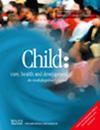Adolescent, Parent and Clinician Perspectives on Time Alone in Chronic Illness Visits at a Single Children's Hospital
Abstract
Background
Time alone between adolescents with chronic illnesses and their clinicians may contribute to patient-centred care and transition readiness within this population. Shifts in the adolescent–parent–clinician relationship underpin this contribution; as such, this qualitative study explored adolescent, parent and clinician perspectives on time alone in routine visits for paediatric chronic illness.
Methods
Semi-structured interviews with English-speaking adolescents (ages 12–17, n = 65) and their parents (n = 63) were conducted after follow-up visits for inflammatory bowel disease (IBD), juvenile idiopathic arthritis (JIA), sickle cell disease (SCD) or type 1 diabetes (TID) at specialty clinics affiliated with the Children's Hospital of Philadelphia. Clinicians (n = 16) at the same clinics were also interviewed for this cross-sectional qualitative study. Interviews were transcribed, and thematic analysis was performed using an inductive approach.
Results
Qualitative analysis yielded six themes: (1) Clinician, parent and adolescent factors influence provision of time alone; (2) some adolescents communicate more openly with their clinician during time alone; (3) some adolescents do not share new information during time alone; (4) time alone facilitates the development of the clinician-adolescent relationship and helps prepare the adolescent for the transition to adult care; (5) clinicians continuously re-negotiate the parent–adolescent–clinician relationship to meet adolescents' needs; and (6) time alone can raise challenges for clinicians.
Conclusion
Time alone can affect information sharing and relationship building between adolescents with chronic illnesses and their clinicians. By fostering open communication and trust in the adolescent–clinician relationship, time alone may help prepare adolescents with chronic illnesses for the transition to adult care.

 求助内容:
求助内容: 应助结果提醒方式:
应助结果提醒方式:


